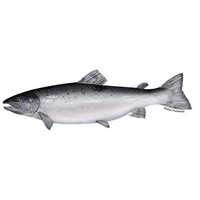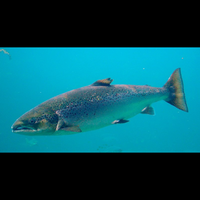Salmo Salar.
Species description.
Salmo Salar or Atlantic salmon is a well known salmon found in Europe and north-America. And it is the only salmon that is not in the Oncorhynchus genus. They are mostly anadromous but there are a few land locked populations found throughout its range. Unlike pacific salmon about 5-10% of spawning adults survive and return to sea after spawning, to spawn again next year. These fish especially can grow and become real giants with records of 160cm in length and 49,44kg in weight. Although most of the salmon only reach 75cm after two years at sea and then die after spawning.
Behaviour.
When Atlantic salmon hatch they spent the first years (between 1 and 8) in fresh water, the length of this period is dependant on things like location, temperature and food availability. During their time in freshwater they mostly feed on aquatic insects and larva and other small insects. When they are ready, they develop into smolts and begin their trip to the Atlantic ocean. This happens mostly between March an June. After their migration to the ocean their growth accelerates and they grow for 1 up to 4 years and then return to their birth stream to reproduce.
History.
Once Atlantic salmon where found throughout Europe and the U.S. but their numbers have declined greatly, the amount salmon where estimated to be around 8 million in 1980 and nowadays these number have gone down to around 3 million fish. Especially in the latest years in most rivers the returning numbers are very low. And even rivers that where great salmon fishing rivers have been closed for the season because the number of fish returning where to low. In the 1970-1990 fishing has made a big impact on the numbers of salmon with harvest peaking in 1973 (3,5 million salmon) and staying around 2 million a year until the late 1980s.
Threats.
Numbers of Atlantic salmon have declined due to multiple causes and some of these are still threats to the species. Fishing still has a big impact but harvesting has gone down to less than 0,5 million. Pollution (ironically also due to salmon farms) and climate change are having big impact on populations. In some rivers dams making it hard or impossible to reach their spawning grounds also contribute to the decline. And even salmon farming has an impact on the species, farming in open waters pollutes these waters but also increases the problems with sea lice and diseases. Escaping fish with bad genetics mixing with wild populations also happens in some occasions.
Distribution.
Within Europe Salmo Salar is found in rivers draining into the Atlantic ocean and Baltic sea. This includes the following countries: Belgium, Denmark, England, Estonia, Finland, France, Germany, Iceland, Ireland, Latvia, Lithuania, Netherlands, Northern Ireland, Norway, Poland, Portugal, Scotland, Slovakia, Spain, Sweden, Wales. For fishing the best regions are Scandinavia, the UK and Iceland.

